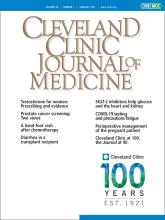Article Figures & Data
Tables
EMPA-REG OUTCOME21 CANVAS22 DECLARE-TIMI 5823 VERTIS-CV24 Population Type 2 diabetes + cardiovascular disease Type 2 diabetes + cardiovascular disease or multiple risk factors for it Type 2 diabetes + cardiovascular disease or multiple risk factors for it Type 2 diabetes + cardiovascular disease Number of patients 7,020 10,142 17,160 8,246 History of cardiovascular disease 99% 65.6% 40.6% 100% History of heart failure 10.1% 14.4% 10.2% 23.7% Outcomes with SGLT-2 inhibitor MACE (relative risk reduction) 14% 14% Not significant Not significant MACE (number needed to treat) 63 217 Not available Not available Cardiovascular death (relative risk reduction) 38% Not significant Not significant Not significant Hospitalization for heart failure (relative risk reduction) 35% 35% 27% 30% Hospitalization for heart failure (number needed to treat) 71 312 125 91 CANVAS = Canagliflozin Cardiovascular Assessment Study; DECLARE-TIMI 58 = Dapagliflozin Effect on Cardiovascular Events; EMPA-REG OUTCOME = Empagliflozin Cardiovascular Outcome Event Trial in Type 2 Diabetes Mellitus Patients; MACE = major atherosclerotic cardiovascular events; VERTIS CV = Evaluation of Ertugliflozin Efficacy and Safety Cardiovascular Outcomes
Benefits Risks Hemoglobin A1c Weight and blood pressure Heart failure hospitalizations Cardiovascular events Progression of renal disease Fracture, amputation Genital infection Empagliflozin Decrease Decrease Decrease Decrease Decrease No change Increase Canagliflozin Decrease Decrease Decrease No change Decrease No changea Increase Dapagliflozin Decrease Decrease Decrease No change Decrease No change Increase Ertugliflozin Decrease Decrease Decrease No change No change No change Increase ↵a Changed from “increases risk” to “no change” after the removal of the black box warning by the US Food and Drug Administration.






